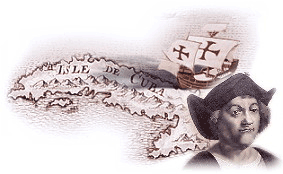|
We do not know when it was first grown, or smoked, but we can be pretty certain
that the inhabitants of Europe were unaware of tobacco until after Columbus s
epic voyage of 1492.
 Two of his sailors reported that the Cuban Indians smoked a primitive form of
cigar, with twisted, dried tobacco leaves rolled in other leaves such as palm or
plantain. In due course, Spanish and other European sailors caught the habit, as
did the Conquistadors, and smoking spread to Spain and Portugal and eventually
France, most probably through Jean Nicot, the French ambassador to Portugal, who
gave his name to nicotine. Later, the habit spread to Italy and, after Sir
Walter Raleigh's voyages to America, to Britain. Two of his sailors reported that the Cuban Indians smoked a primitive form of
cigar, with twisted, dried tobacco leaves rolled in other leaves such as palm or
plantain. In due course, Spanish and other European sailors caught the habit, as
did the Conquistadors, and smoking spread to Spain and Portugal and eventually
France, most probably through Jean Nicot, the French ambassador to Portugal, who
gave his name to nicotine. Later, the habit spread to Italy and, after Sir
Walter Raleigh's voyages to America, to Britain.
Smoking was familiar throughout Europe - in pipes in Britain - by the mid-16th
century and, half a century later, tobacco started to be grown commercially in
America. Tobacco was originally thought to have medicinal qualities, but there
were already some who considered it evil and it was denounced by Philip II of
Spain, and James I of England. The word cigar originated from sikar, the Mayan-Indian
word for smoking, which became cigarro in Spanish, although the word itself, and
variations on it, did not come into general use until the mid-18th century.
Cigars, more or less in the form that we know them today, were first made in
Spain in the early 18th century, using Cuban tobacco. At that time, no cigars
were exported from Cuba.
By 1790, cigar manufacture had spread north of the Pyrenees, with small
factories being set up in France and Germany.
The Dutch, too, started making cigars using tobacco from their Far Eastern
colonies. But cigar smoking only became a widespread custom in France and
Britain after the Peninsular War (1808-14), when returning British and French veterans made fashionable the habit
they had learned while serving in Spain.
Production of "segars" began in Britain in 1820, and in 1821 an Act of
Parliament was needed to set out regulations governing their production. Because of an import tax, foreign
cigars in Britain were already regarded as a luxury item.
Soon there was a demand for higher quality cigars in Europe, and Spanish cigars
were superseded by those made in Cuba, which was then a Spanish colony, where
cigar production had started during the mid-18th century. Cigars, European
smokers discovered, traveled better than tobacco. The cigar probably arrived in
North America in 1762, when Israel Putnam, later an American general in the
American War of Independence (1774-1778), returned from Cuba, where he had
served in the British army. He came back to his home in Connecticut, where
tobacco had been grown by settlers since the 17th century, with a selection of
Havana cigars and large amounts of Cuban tobacco seed. Cigar factories were
later set up in the Connecticut area, processing the tobacco grown from the
Cuban seed. In the early 19th century American domestic production started to
take off and Cuban cigars also began to be imported in significant numbers. But
cigar smoking did not really boom in the United States until around the time of
the Civil War in the 1860s, with individual brands emerging by the late 19th
century. By then the cigar had become a status symbol in the United States.
During the same period, cigar smoking had become so popular among gentlemen in
Britain and France that European trains introduced smoking cars to accommodate them, and
hotels and clubs boasted smoking rooms. The after-dinner cigar, accompanied by
glasses of port or brandy, also became a tradition. This ritual was given an
added boost by the fact that the Prince of Wales, the future Edward VII and a
leader of fashion, was a devotee, much to the annoyance of his mother, Queen
Victoria, who disliked smoking.
Cigarettes, or paper cigars, first appeared on the scene in the early 19th
century as a cheap alternative to cigars. The introduction of cigarette-making machines, in the
1880s, accelerated the growth in popularity of this form of smoking, which had
become dominant by World War I.
As a response, the production of machine-made cigars began in Cuba in the 1920s,
after which both the manufacture and smoking of handmade cigars fell into a slow
but steady decline.
Smoking in general has, of course, become much less popular since the
publication of the American Surgeon General's report on its effects on health in
the early 1960s. But since the early 1990s, there has been a major revival in
the popularity of handmade cigars: they have become chic once more, thanks to the enthusiasm shown for them by stars, such as Arnold Schwarzenegger, James Woods, Jack Nicholson, Sharon Stone, Demi Moore and model
Linda Evangelista, demonstrating that, among the rich and famous, cigars are
just as popular as ever.
|
|



